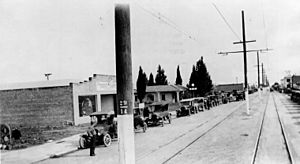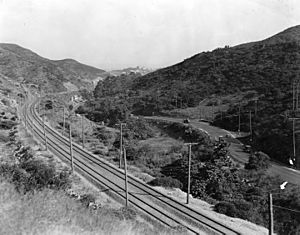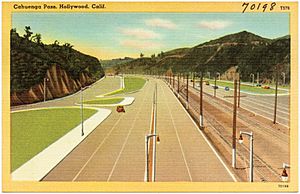Owensmouth Line facts for kids
Quick facts for kids Owensmouth |
|
|---|---|

Sherman Way in Owensmouth, 1920, with Los Angeles Pacific Railroad lines
|
|
| Overview | |
| Owner | Southern Pacific Railroad |
| Locale | Los Angeles and the San Fernando Valley |
| Termini | Downtown Los Angeles Owensmouth-Canoga Park, California |
| Stations | 34 |
| Service | |
| Type | Interurban |
| System | Pacific Electric |
| Operator(s) | Pacific Electric |
| Rolling stock | PE 5050 Class (last used) |
| Ridership | 1,038,622 (1926) |
| History | |
| Opened | December 16, 1911 (to Van Nuys) December 7, 1912 (Owensmouth) |
| Closed | June 1, 1938 (Canoga Park–Sherman Way) December 29, 1952 (all service) |
| Technical | |
| Line length | 29.1 mi (46.8 km) |
| Track gauge | 4 ft 8 1⁄2 in (1,435 mm) standard gauge |
| Electrification | 600 V DC overhead line |
The Owensmouth Line was a special train service run by Pacific Electric. It connected the San Fernando Valley to Downtown Los Angeles. This train line was mostly built to help sell land in the area.
Contents
History of the Owensmouth Line
The train service to Owensmouth (which is now called Canoga Park) was a big part of a plan to develop land in Southern California. In 1910, a group of rich investors bought almost the entire southern San Fernando Valley. These investors included famous people like Harrison Gray Otis and Harry Chandler.
They planned to build new towns and needed a way for people to get there. Even though the Los Angeles Aqueduct was being built nearby, the train line was planned separately.
To help sell the land, General Moses Sherman's Los Angeles Pacific Railroad started building a train line. This line would go across the San Fernando Valley to serve three new towns: Van Nuys (1911), Marion (now Reseda), and Owensmouth (now Canoga Park) (1912). Back then, train lines were seen as a must-have for new developments.
Next to the train line, a special road called Sherman Way was built. It was a wide, paved road with no speed limit, where cars could go up to 35 miles per hour! There was also a separate dirt road for farm wagons. The Los Angeles Pacific Railroad later sold this line to the Pacific Electric company. The train line opened to Van Nuys on December 16, 1911. It then extended all the way to Owensmouth on December 7, 1912.
Owensmouth got its name because it was thought to be close to the "mouth" of the Owens River Aqueduct. This was a way to make the area sound more appealing. However, it was actually 20 miles away and used well water. In 1917, it became part of Los Angeles. Because of some disagreements about land and the aqueduct, the community changed its name to Canoga Park in 1931. This new name came from the Southern Pacific "Canoga" train station. Even with the name change, the Pacific Electric line kept its original name, Owensmouth, until it stopped running.
The train line originally had its own special path through the Cahuenga Pass. This path was on the west side of the main highway. Later, when the Hollywood Freeway was built, the train line was moved to the middle section of the freeway.
Train services were shortened on June 1, 1938. Finally, buses replaced all train services on December 28, 1952. Interestingly, unlike other train lines that saw fewer riders after World War II, the Owensmouth Line actually had many more passengers in its last years.
The G Line Today
In the 2000s, a new public transport line was built across the Valley. It's called the Metro Orange Line, and it uses special bus lanes. Part of this new bus line uses the old Pacific Electric train path. It also uses parts of another old train route. This bus service started in 2005 and was renamed the G Line in 2020.
Route of the Owensmouth Line
The Owensmouth Line started in Downtown Los Angeles, sharing tracks with the Hollywood Line. It then continued along the South Hollywood–Sherman Line at Sunset Junction. From there, it turned north at Highland.
The line then went through the Cahuenga Pass on its own special path. It turned onto Vineland Avenue through North Hollywood and then onto Chandler Boulevard. It continued west to a curve onto Van Nuys Boulevard, going through Van Nuys. At Sherman Circle, it turned west onto Sherman Way, leading all the way to Owensmouth. On Shoup Avenue, named after the Pacific Electric president Paul Shoup, the train used the center of the road for its final stops.
Main Stations Along the Line
Ridership Numbers
This table shows how many passengers rode the Owensmouth Line over the years. It also shows how many miles the trains traveled and how much money was made.
| Year | Passengers | Car Miles | Revenue |
|---|---|---|---|
| 1913 | 368,688 | 276,895 | $ 81,917 |
| 1914 | 487,907 | 378,151 | $115,228 |
| 1916 | 454,942 | 315,820 | $ 88,879 |
| 1918 | 499,282 | 381,858 | $101,452 |
| 1920 | 815,483 | 394,132 | $191,198 |
| 1922 | 795,906 | 494,037 | $202,058 |
| 1924 | 912,075 | 585,773 | $219,281 |
| 1926 | 1,038,622 | 624,206 | $225,957 |



